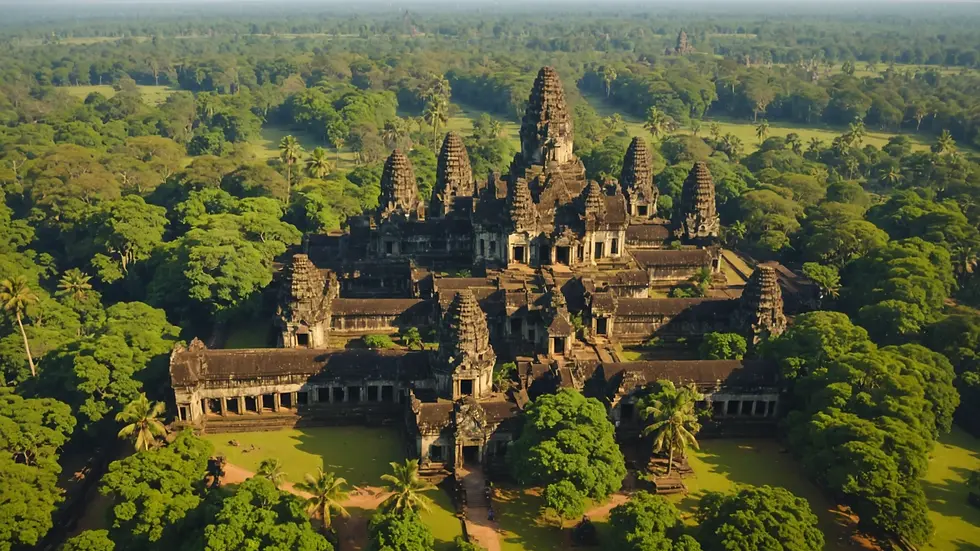Uncovering the Mysteries of Angkor Wat: Exploring the Ancient Temples and Tranquil Landscapes
- dknegi4444
- Dec 31, 2024
- 4 min read
Angkor Wat, one of the most iconic archaeological sites in the world, invites visitors to journey back in time through its stunning architecture and serene surroundings. As the largest religious monument globally, this UNESCO World Heritage Site boasts a rich history intertwined with myth and mystery. Surrounded by lush jungle, tranquil lakes, and a vibrant local culture, Angkor Wat fosters a sense of peace that captivates all who come to explore its ancient temples.
A Brief History of Angkor Wat
Constructed in the early 12th century during the reign of King Suryavarman II, Angkor Wat was originally designed as a Hindu temple dedicated to the god Vishnu. Over the centuries, it gradually transformed into a Buddhist temple, reflecting the cultural evolution of the region. The grandeur of its architecture and intricate bas-reliefs tells the story of Cambodia's rich history, encompassing religious devotion, the artistry of the Khmer Empire, and the resilience of the Cambodian people.
Angkor Wat stands as a symbol of national pride for Cambodians. Its design serves as a blueprint for Khmer architecture and represents the pinnacle of creative artistry with its symmetrical layout and magnificent central tower symbolizing Mount Meru, the center of the universe in Hindu cosmology.

The Awe-Inspiring Architecture
One of the most breathtaking elements of Angkor Wat is its grand architectural style. From the moment visitors approach through the extensive causeway, the beauty of the structure becomes apparent. The temple complex primarily consists of five central towers representing the peaks of Mount Meru, surrounded by a wide moat and an intricate network of galleries and halls.
The temple's layout is designed to represent the cosmic world, with the outer walls symbolizing the surrounding ocean and the moats representing the sea encircling the base of the sacred mountain. The stunning bas-reliefs that adorn the walls recount tales from Hindu epics, showcasing the craftsmanship and storytelling ability of the Khmer artisans.
Visitors can spend hours wandering through the halls, absorbing the artistry while illuminated by the soft play of natural light filtering through openings in the stone.
Spiritual Significance and Peacefulness
Angkor Wat
Angkor Wat's serene surroundings add to its spiritual allure. The landscape’s tranquil lakes and dense forests create a perfect setting for reflection and meditation. Many visitors find peace amid the ancient stones, listening to the soft rustle of leaves and the gentle sounds of nature.
Walking through the temple grounds, one often encounters local monks in saffron robes, engaging in quiet rituals and meditation. Their serene presence enhances the atmosphere, inviting travelers to pause, contemplate, and connect with the spiritual essence of the site.

Timeless Beauty at Different Times of Day
One of Angkor Wat's most magical experiences occurs at dawn and dusk. As the first light of day rises, the temple's silhouette is reflected in the still waters of the moat, creating a breathtaking sight that enchants early risers. The play of colors against the temple's stone faces captures the heart and soul of this ancient monument, reminding visitors of its timeless beauty.
At sunset, the surrounding landscape offers an equally stunning vista. The warm hues of a Cambodian sunset, combined with the majestic temples, create a picturesque panorama that guests will remember long after their visit.
Practical Tips for Visiting Angkor Wat
Visiting Angkor Wat requires a bit of planning to fully appreciate its vastness and history. Here are some practical tips for an enriching experience:
Best Time to Visit
The best months to visit are during the dry season from November to March. The cooler temperatures make it more comfortable for exploring the temple complex. Early mornings are ideal for avoiding crowds and witnessing breathtaking sunrises.
Entry Tickets
Entry to Angkor Wat requires a ticket, which can be purchased for one day, three days, or seven days. The three-day pass is one of the most popular choices, allowing ample time for exploration while minimizing the rushed experience.
Guided Tours
Consider opting for a guided tour to maximize your understanding of the history and significance of the site. Local guides can share in-depth knowledge about the architecture, cultural importance, and fascinating stories surrounding Angkor Wat.
Respect Local Customs
When visiting the temple, it’s vital to dress modestly as a sign of respect. Shoulders and knees should be covered, and it is advisable to wear comfortable shoes suitable for exploring the extensive grounds.
Exploring Beyond Angkor Wat
While Angkor Wat is undoubtedly a highlight, the greater Angkor Archaeological Park hosts numerous other significant sites worth exploring. Temples like Ta Prohm, known for its roots intertwined with ancient stones, and Bayon Temple, famous for its multitude of serene stone faces, offer captivating experiences that reflect the grandeur of the Khmer Empire.
The beautiful landscapes surrounding the temples are also worth discovering. Visit the nearby Tonle Sap Lake, home to floating villages and diverse wildlife, providing an insight into the local way of life.
Conclusion
Angkor Wat stands as a living testament to Cambodia’s rich history, artistry, and spiritual depth. With its breathtaking architecture, serene surroundings, and profound sense of peace, the ancient temples draw visitors seeking both adventure and solace in their journey.
Exploring Angkor Wat is not merely a visit to an archaeological wonder; it is an opportunity to connect with a significant piece of human history and reflect on the beauty of the world around us. As visitors walk among the stones and soak in the tranquility of the landscape, they find themselves uncovering the mysteries not only of Angkor Wat but also of their inner selves.



Comments